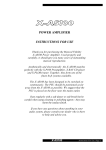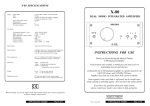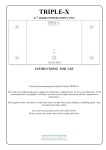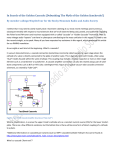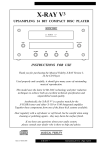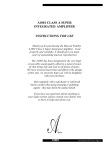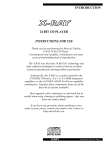Download Musical Fidelity X-AS100 Specifications
Transcript
REMOTE CONTROL CLASS A PREAMPLIFIER INSTRUCTIONS FOR USE Thank you for purchasing the Musical Fidelity X-P100 Remote Control Class A Pre-Amplifier. Used properly and carefully, it should give you many years of outstanding musical reproduction. This X-P100 is closely based on our highly regarded (and now unavailable) Nu-Vista model but uses a specially selected J-FET in place of the Nuvistor triode. The X-P100 has been designed to offer almost indistiguishable sonic charateristics to the Nu-Vista. Aesthetically and electronically the X-P100 matches perfectly with the X-AS100 power amplifier, X-RAY 24 bit CD player and X-PLORA tuner. Together, they form one of the finest hi-fi systems available. Dust regularly with a soft duster or soft brush but be careful when using cleaning or polishing agents - they may harm the surface finish. If you have any questions about anything in your audio system, please consult your dealer who is there to help and advise you. X-P100 Instructions For Use. Page 1 PLEASE READ IMPORTANT! This unit is supplied in the UK with a mains lead fitted with a moulded 13 amp plug. If, for any reason, you need to cut off this plug, please observe the following safety precautions. Please dispose of the cut-off plug safely. It must not be plugged into a mains power supply. The wires in the mains lead supplied with this appliance are coloured in accordance with the following code: Green and yellow..............Earth Blue...............................Neutral Brown................................Live WARNING - This appliance must be earthed As the colours of the wires of the mains lead of this appliance may not correspond with the coloured markings identifying the terminals in your plug, proceed as follows: • The wire which is coloured green-and-yellow must be connected to the terminal in the plug which is marked with the letter E or coloured green or green-and-yellow, or by the earth symbol . •The wire which is coloured brown must be connected to the terminal which is marked with the letter L or coloured red. •The wire which is coloured blue must be connected to the terminal which is marked with the letter N or coloured black. •If connecting to a BS1363 plug, a 10 amp fuse must be used. WARNING - Radio Frequency Interference (RFI) This hi-fi product has been tested to ensure that its operation will not be adversely affected by normal background levels of RFI. It is possible that if this product is subjected to abnormally high levels of RFI the unit may be susceptible and not perform as expected. In the unlikely event of this happening on a regular basis, please contact Musical Fidelity's service department. The unit has also been tested to ensure that it does not radiate excessive levels of RFI that could affect other pieces of electronic or electrical equipment. The electronics in modern hi-fi equipment is complex and hence may be damaged by lightning. It is possible that during electrical storms the operation of some equipment may be adversely affected. For complete protection of your hi-fi system during such storms, mains plugs and aerial leads should be disconnected. Always ensure that when disconnecting and reconnecting your hi-fi equipment the mains supply is switched off. X-P100 Instructions For Use. Page 2 CONNECTIONS AND FACILITIES 1 2 3 4 FRONT VIEW 1 2 3 4 5 5 BACK VIEW Main unit power on indicator LED Volume control Infra Red remote receiver lens Tape monitor button Source selector switch 6 7 8 6 7 8 9 10 11 12 13 14 15 9 X-P100 10 Input from external PSU unit Tape record output Tape input Aux 2 input Aux 1 input Tuner input CD input Preamp Output Phono (MM) input Phono chassis earth 11 12 13 14 15 Instructions For Use. Page 3 INSTALLATION INSTALLATION PRECAUTIONS Your new X-P100 is designed and built to provide trouble-free performance but as with all electronic devices it is necessary to observe a few precautions. Please ensure that you have complied with them before you connect any AC power to your amplifier. Retain this guide for future reference. þ Heed all warnings on the back of the unit. þ Place your X-P100 where there is adequate ventilation. þ Only connect the unit to a power supply of the type marked on the back of the unit. þ Position the power supply lead and signal interconnect leads where they are not likely to be walked on or trapped by items placed on them. ý Do not use near water. ý Do not place the units near direct heat sources such as radiators or other equipment that produces heat. ý Do not remove any covers or try to gain access to the inside. The warranty will be invalid if the unit has been tampered with. There are no user adjustments within. Refer all service work to an authorised Musical Fidelity agent. BEFORE YOU SWITCH ON You should make all connections to the X-P100 before switching on. Follow this routine before you listen for the first time, and each time you change any connections. 1 2 3 4 Check all the inputs and outputs to the X-P100. Then check again. Turn the volume control to nil. Now you can switch on the power and carefully advance the volume to the level you want and enjoy the music. X-P100 Instructions For Use. Page 4 CONNECTIONS INTRODUCTION Congratulations on your purchase of an X-P100 remote control Class A preamplifier. The X-P100 is a new model based on our innovative and now very highly regarded Nu-Vista valve preamp but using Field Effect Transistors in place of the Nuvistor valves used in that model. These transistors were carefully selected from the great many alternatives we tested because of their close similarity in both measured perfomance and sonic fingerprint to the 6CW4 Nuvistor. We feel that the X-P100 offers a very similar level of sonic fidelity to the Nu-Vista but at the reduced cost afforded by the choice of FET devices. The X-P100 preamp also features full remote control and a high quality discrete MM phono stage. EXTERNAL POWER SUPPLY AND SETTING UP The X-P100 is supplied with an external power supply which is connected to the main unit via an umbilical lead terminated in an XLR/Cannon type plug. This lead should be connected to the socket on the back of the X-P100 main unit. CONNECTIONS All connections should be made with the power OFF. The X-P100 has 5 line level inputs - CD, Tuner, Aux1, Aux2 and Tape, plus an MM phono input. All line inputs are electrically identical and are suitable for use with any source component with an output voltage in the hundreds of millivolts (mV). This includes CD players, tuners, tape machines and the audio outputs of video recorders, televisions, DVD and LaserDisc players etc. The high quality phono input caters for turntables fitted with a Moving Magnet type cartridge or other cartridges with an output voltage in the range 1 to 5mV. TAPE RECORDING Caution - This power supply is for use only with the Musical Fidelity X-P100. Do not plug the power supply into any other unit. Important - follow the following procedure when setting up the X-P100 for the first time or if you should need to re-site your X-P100. 1. Make sure that the PSU unit is switched off (front panel button in the 'out' position) and that the PSU's mains lead is disconnected. 2. Plug the umbilical lead from the XP100 PSU into the back of the X-P100 main unit 3. Connect the supplied mains lead from the IEC type socket on the back of the PSU unit and to a suitable mains outlet. 4. Switch on your X-P100 using the On/Off button which is situated on the XP100 PSU front panel. After a delay of approximately 10-15 seconds the unit will un-mute and is ready for use. The X-P100 has a single tape circuit with facilities for off-tape monitoring with 3head cassette decks. Connection of your tape machine to the X-P100 should be as follows. The tape machine's Tape/Line outputs go to the X-P100's 'Tape' input sockets. The tape machine's Tape/Line inputs go to the X-P100's 'Tape Record' output. To record simply select the required source with the source selector knob on the front panel. The selected source will now be sent to the 'Tape Record' output for recording by the attached tape machine. X-P100 Instructions For Use. Page 5 CONNECTIONS You will also be able to hear the selected source through the loudspeakers. Note - you can adjust the listening level with the volume control without affecting the recording level. OFF TAPE MONITORING In conjunction with a 3-head cassette deck, off-tape monitoring allows the user to compare the recorded to original sound whilst a recording is made. To do this first select the required source in the normal way and start recording. The Tape Monitor button on the front panel can now be used to switch between the source signal and the recorded signal allowing direct comparison. Note that tape (the recorded signal) is selected when this button is in. On some 3head cassette decks there is an additional 'tape/source' switch which will need to be in the 'tape' position for the above to work - if you are in any doubt consult your tape machine's manual. Input selection is achieved by a motorised selector switch which will automatically turn to the input selected with the remote handset. Please note that if the selector switch is not firmly positioned on a valid input when a new selector postion is selected on the remote contro,l the X-P100 will turn the selector switch to its first position, (Tape), and reset the selector control mechanism before then moving on to the correct input. The output is muted whilst the selector switch rotates by remote control. The mute button on the remote handset mutes the output from the preamp, pressing this button again or selecting a different input selection will un-mute the unit. REMOTE CONTROL The X-P100 features Infra Red remote control of volume, input selection and mute functions via the supplied remote control handset. The Infra Red receiver is the small red lens marked I.R. situated on the front panel, it is a good idea to place your X-P100 such that there is an unobstructed line-of-sight to this lens from around your listening room. Pressing the volume up or down buttons on the remote handset will advance the motorised volume control in the desired direction. If either button is held down for more than approximately 2-3 seconds the motor drive will go into high speed mode and the volume control will advance more rapidly. X-P100 Instructions For Use. Page 6 TROUBLESHOOTING Basic troubleshooting of an amplifier is similar to troubleshooting of any other electrical or electronic equipment. Always check the most obvious possible causes first. To give you a few ideas of what to look for, check the following: Problem Probable Cause Remedy No power when POWER is pressed Mains plug not inserted correctly Plug in securely PSU unit not connected to main unit Plug PSU umbilical lead into back of main X-P100 unit Volume control is set to minimum Turn up the volume Mute is selected Press mute button on remote control Preamplifier not connected to Power amplifier Check phono cable connection between units Unit has not yet come out of power-up mute Wait 10-15 seconds on power-up for unit to un-mute Tape Monitor button is depressed Press Tape monitor button No sound Speakers are not connected, Check speaker cables or are connected incorrectly Sound is not precise, lacking in bass and stereo image Speakers are connected out of phase Make sure that both speakers are connected correctly If none of these actions effect a cure, please contact your dealer, or an authorised Musical Fidelity service agent. Remember, never open the case of the X-P100 yourself, as this will invalidate the guarantee. X-P100 Instructions For Use. Page 7 SPECIFICATIONS REMOTE CONTROL CLASS A PREAMPLIFIER Inputs THD Frequency response S/N ratio Dimensions Power consumption Standard accessories 5 Line, MM phono < 0.007% 20Hz - 20kHz unweighted < 0.004% 20Hz - 20kHz ‘A’ weighted 20Hz - 20kHz + 0.2dB MM phono > 72dB unweighted MM phono > 78dB 'A' weighted Line > 81dB unweighted Line > 90dB ‘A’ weighted 230 x 110 x 315mm (W x H x D) Width and height include feet 20 watts (maximum) Remote control handset X-P100 power supply unit IEC type mains lead 2 x batteries (AA, SUM-3, CR6) Musical Fidelity reserves the right to make improvements which may result in specification or feature changes without notice. X-P100 Instructions For Use. Page 8 X-P100-98-1









